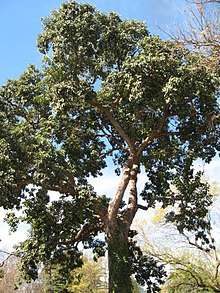Bischofia javanica
Bischofia javanica, or bishop wood, is a plant species of the family Phyllanthaceae. It and the related Bischofia polycarpa are the only two members of genus Bischofia and tribe Bischofieae. These species are distributed throughout southern and southeast Asia to Australia and Polynesia also in North America (brought to North America as a decorative plant but now considered to be an invasive species). The tree is commonly used by tigers to scratch-mark territory in the jungles of Assam where it is locally called uriam. They also occur in southwestern, central, eastern, and southern China, and also Taiwan, where aboriginal people consider it a sacred tree.[1][2]
| Bishop wood | |
|---|---|
 | |
| Scientific classification | |
| Kingdom: | Plantae |
| Clade: | Tracheophytes |
| Clade: | Angiosperms |
| Clade: | Eudicots |
| Clade: | Rosids |
| Order: | Malpighiales |
| Family: | Phyllanthaceae |
| Genus: | Bischofia |
| Species: | B. javanica |
| Binomial name | |
| Bischofia javanica | |
Uses
- The dark red, dense wood is used as a building material for items ranging from furniture to bridges; it is durable but is difficult to air-dry.
- The fruits are used in making wine.
- The seeds, which are edible, contain 30-54% oil, which is used as a lubricant.
- The bark has a high tannin content and is used as a source of red dye to stain rattan baskets.[3]
- The roots are used medicinally.[1]
- The leaves are eaten in Southern Laos dipped into chili sauce.
gollark: I agree.
gollark: It's victim-blaming.
gollark: That is a bad argument.
gollark: As a helper, I will use my blue name powers to MILDLY CRITICIZE anyone who does it.
gollark: No doxxing. Stalking bad, doxing especially bad.
References
- Hao Zheng; Yun Wu; Jianqing Ding; Denise Binion; Weidong Fu & Richard Reardon (September 2004). "Bischofia javanica (Bishop wood)". Invasive Plants of Asian Origin Established in the US and Their Natural Enemies (PDF). USDA Forest Service. pp. 34–35. Archived from the original (PDF) on 2006-09-28. Retrieved 2006-11-17.
- Li Bingtao (1994). Li Bingtao (ed.). "Bischofia Bl". Flora Reipublicae Popularis Sinicae. Science Press. Beijing, China. 44 (1): 184–188.
- Gardner, Simon, Pindar Sidisunthorn, and Vilaiwan Anusarnsunthorn. A Field Guide to Forest Trees of Northern Thailand. Bangkok: Kobfai Publishing Project, 2000.
This article is issued from Wikipedia. The text is licensed under Creative Commons - Attribution - Sharealike. Additional terms may apply for the media files.